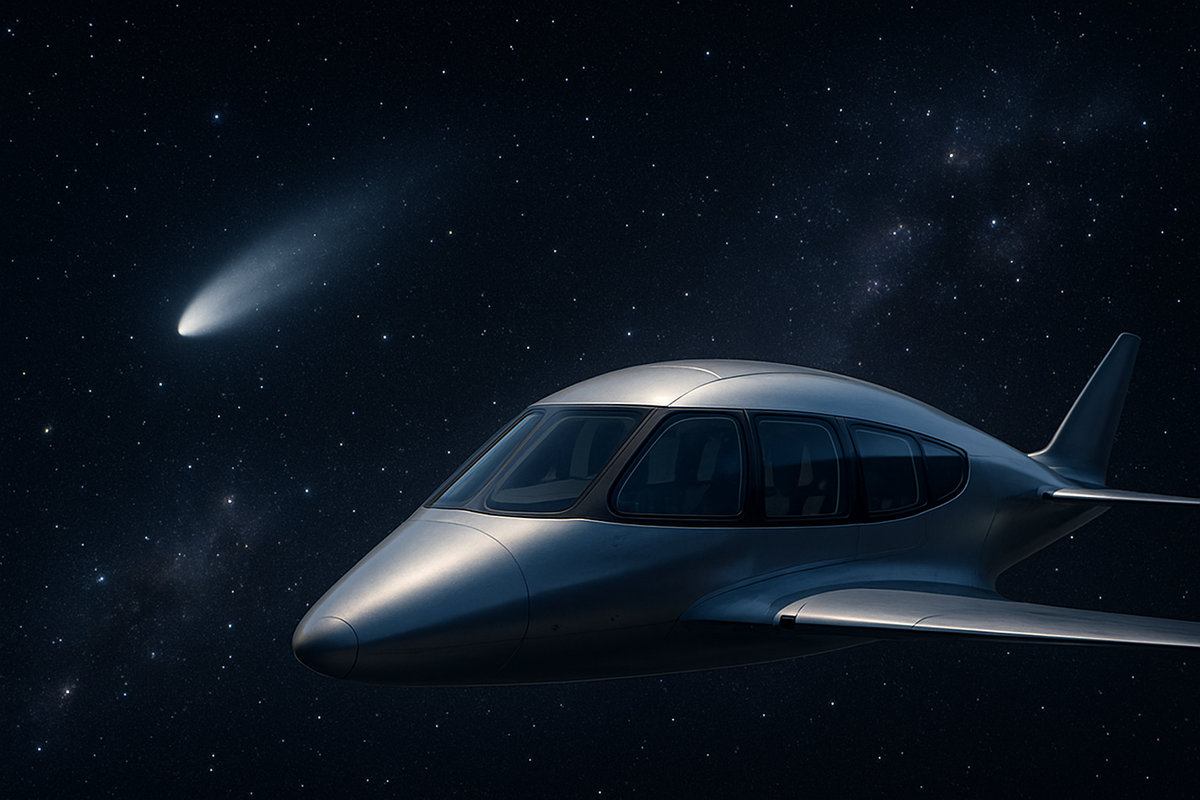
October 6, 2025 - The prospect of journeying to the edge of space to witness an interstellar comet, a cosmic wanderer from beyond our solar system, ignites the imagination and underscores the profound allure of space tourism. While the idea of Virgin Galactic (NYSE: SPCE) launching 'ATLAS Viewing Flights' to observe the enigmatic interstellar comet 3I/ATLAS has captured significant public interest, current realities in commercial spaceflight paint a different picture. As of today, Virgin Galactic's focus remains firmly on suborbital tourism, offering unparalleled views of Earth and moments of weightlessness, rather than dedicated astronomical observation missions for distant celestial bodies.
This distinction is crucial for understanding the evolving landscape of space tourism. While comet 3I/ATLAS continues its fascinating journey through our solar system, captivating scientists worldwide, the commercial space industry, led by pioneers like Virgin Galactic, is still in its nascent stages of making space accessible. The hypothetical 'ATLAS Viewing Flights' highlight a potential future direction for space tourism—one that could merge adventure with scientific observation—but also underscore the significant technological and operational hurdles that must be overcome before such specialized journeys become a reality.
The Reality of Comet 3I/ATLAS and Virgin Galactic's Earth-Bound Vision
Interstellar comet 3I/ATLAS (officially C/2025 N1 (ATLAS)), the third confirmed interstellar object to visit our solar system, was discovered on July 1, 2025, by the NASA-funded ATLAS survey telescope. Its hyperbolic trajectory confirms its origin from another star system, a truly rare astronomical event. As of October 6, 2025, the comet is actively traversing our solar system, having made its closest approach to Mars on October 3, 2025. It is set to reach perihelion (closest approach to the Sun) on October 30, 2025, just inside Mars' orbit. While it will pass Earth at a safe distance on December 19, 2025, it is currently difficult to observe from Earth with ground-based telescopes due to its proximity to the Sun and will reappear for observation in early December. Scientific agencies, including NASA (with Hubble and James Webb Space Telescopes) and ESA (with Mars Express and JUICE), are extensively studying its unique composition, rich in carbon dioxide and other volatiles, to glean insights into exoplanetary systems.
In stark contrast to this grand astronomical spectacle, Virgin Galactic's operations are centered on providing suborbital space tourism experiences. Founded by Richard Branson, the company's mission is to offer private citizens the sensation of weightlessness and breathtaking views of Earth's curvature from above the Kármán line (approximately 100 kilometers or 62 miles altitude). Their VSS Unity spaceplane completed its final commercial flight in June 2024, after 12 spaceflights, to make way for the next generation of Delta class spaceships. These new vehicles, currently under construction and ground-testing, are designed for significantly higher operational efficiency and capacity, aiming to carry six passengers per flight with a rapid turnaround time. The first Delta class flights are slated to begin in 2026, with private astronaut flights expected by Fall 2026. The company's strategic pivot is towards scaling its suborbital offering, targeting a flight cadence of twice a week by 2028, with tickets for the Delta class expected to be around $600,000. This current operational focus means that dedicated, specialized astronomical viewing flights for objects like 3I/ATLAS are not part of Virgin Galactic's immediate or projected service offerings.
The Market's Gaze: Winners, Losers, and the Lure of Specialized Space Experiences
The idea of specialized astronomical viewing flights, even if currently hypothetical for Virgin Galactic, presents a fascinating thought experiment for the space tourism market. If such offerings were to materialize, they would undeniably create a new, high-value niche, primarily appealing to ultra-high-net-worth individuals and serious astronomy enthusiasts. Companies capable of offering these unique experiences would gain a significant competitive edge, tapping into a market segment distinct from those seeking only the "Overview Effect" or a brief moment of weightlessness. This could lead to new revenue streams, foster technological advancements in optics and spacecraft stability, and enhance brand prestige for the pioneering company.
For Virgin Galactic (NYSE: SPCE), the absence of such specialized astronomical viewing flights in its current portfolio poses both challenges and opportunities. On one hand, its current suborbital product, while unique, faces increasing competition from companies like Blue Origin, which also offers suborbital flights. More importantly, it contrasts with the more ambitious orbital and lunar aspirations of SpaceX, which already offers multi-day orbital missions and private trips to the International Space Station (ISS). This limited differentiation contributes to investor skepticism, reflected in the volatility and significant decline of Virgin Galactic's stock from its 2021 peak. The company's profitability hinges on the successful and frequent operation of its Delta class, and a lack of diverse, specialized offerings could limit its long-term appeal and repeat customer base.
Conversely, the potential for specialized astronomical tourism could inspire future strategic pivots. Should the market demand for such experiences grow, Virgin Galactic or other players could adapt by developing spacecraft capable of stable, long-duration observation missions. Companies specializing in advanced optics and sensor technology would find new partnership opportunities. While SpaceX and Blue Origin are not publicly traded in the same way, their broader space ambitions, including lunar missions and advanced orbital capabilities, position them well to potentially incorporate astronomical viewing into future offerings, should they choose to. The financial and technological hurdles are immense, but the allure of offering truly unique celestial encounters remains a powerful motivator for innovation in the burgeoning space tourism sector.
Broader Horizons: Astronomical Tourism in the Evolving Space Landscape
The concept of specialized astronomical viewing flights fits squarely into the broader evolution of the space tourism industry, which is increasingly moving towards diverse, experiential, and niche offerings. The global space tourism market, projected to reach over $10 billion by 2030, is driven by a demand for unique adventures, and celestial observation from above Earth's atmosphere represents the zenith of astrotourism. This trend moves beyond terrestrial dark-sky parks and planetariums, offering an unparalleled immersive experience that caters to a sophisticated clientele eager to engage with the cosmos directly.
The ripple effects of such a development would be profound. Existing terrestrial astrotourism operators might face increased competition for the most affluent clients, but could also benefit from a general surge in interest in astronomy. Competitors in space tourism would either need to develop similar capabilities or risk being outmaneuvered in this high-value segment. Strategic partnerships between space tourism providers and scientific institutions would become vital, potentially integrating citizen science programs or specialized instruments into tourist flights, offering new funding and data collection avenues for researchers. Companies specializing in advanced optics and spacecraft technology would find new markets for their innovations.
However, this expansion also brings significant regulatory and policy implications. The nascent regulatory frameworks for commercial spaceflight, currently overseen by bodies like the FAA, would need to evolve to address new safety protocols for prolonged observation missions, potential interference with scientific endeavors, and the operation of sensitive equipment. International harmonization of space law, particularly concerning safety, liability, and environmental concerns like space debris and light pollution, would become even more critical to manage a burgeoning industry. Historically, the shift from government-led space exploration (e.g., Apollo missions) to private commercial spaceflight (e.g., SpaceShipOne, ISS private missions) has consistently necessitated new regulatory adaptations. Specialized astronomical tourism would be the next frontier in this evolution, mirroring the historical human fascination with celestial events, from Captain Cook's transit of Venus expedition to modern-day deep-space observatories.
What Comes Next: The Future Trajectory of Space Tourism
The short-term future of space tourism (2025-2030) will largely be defined by the maturation of suborbital experiences and the emergence of short orbital stays. Virgin Galactic's Delta class spaceplanes are poised to increase the frequency and capacity of suborbital flights, aiming for commercial private astronaut flights by Fall 2026. Blue Origin will likely expand its suborbital offerings, while SpaceX, through collaborations with Axiom Space, will continue to facilitate orbital missions to the ISS and advance towards private space stations, with the first commercial station anticipated by 2027-2028. High-altitude balloon systems are also gaining traction as a more accessible, albeit lower-altitude, option for space-adjacent views. Costs for suborbital flights are expected to decline, making them more accessible to a broader affluent demographic.
Looking further ahead, beyond 2030, the long-term possibilities for space tourism are truly expansive. Orbital hotels and habitats, offering extended stays from days to weeks, are on the horizon, with companies like Orbital Assembly and Axiom Space actively developing such concepts. The ultimate frontier, lunar and Martian tourism, including flybys and exploration, is being actively pursued by SpaceX with its Starship program. As technology advances and economies of scale take effect, the costs of space travel are expected to decrease significantly, potentially transforming it from an ultra-luxury pursuit into a more mainstream form of adventure travel over decades.
For companies like Virgin Galactic, strategic pivots are essential. Beyond increasing flight cadence with the Delta class, diversification of revenue streams, perhaps through research payloads and educational missions, will be crucial. While specialized astronomical viewing flights may not be an immediate offering, the growing market demand for unique space experiences could compel companies to explore such ventures in the future, possibly through partnerships with astronomical institutions or by developing modular observation platforms. This would require substantial investment in R&D, focusing on long-duration flight capabilities, stable observation platforms, and advanced optics. The market opportunities for ancillary services—from specialized space insurance to luxury pre-flight training—will also expand. However, challenges persist, including the inherent risks of space travel, the need for robust and harmonized regulatory frameworks, and managing environmental concerns. Proactive engagement in shaping these regulations and prioritizing safety will be key to unlocking the full potential of this burgeoning industry.
Wrapping Up: A Glimpse into the Cosmos, and the Market Moving Forward
The notion of Virgin Galactic's 'ATLAS Viewing Flights' to observe an interstellar comet encapsulates the ultimate dream of space tourism: not just to visit space, but to truly engage with its wonders. While such dedicated astronomical missions are not currently offered by Virgin Galactic, the public's fascination highlights a clear demand for more specialized and scientifically enriching space experiences. Virgin Galactic's immediate focus is on scaling its suborbital operations with the new Delta class, aiming to make Earth-gazing and weightlessness more accessible to its extensive backlog of customers. This strategic move is critical for the company's financial viability and market position.
Moving forward, investors should closely watch Virgin Galactic's progress with its Delta class development and commercial flight cadence. Success in these areas will be paramount for revenue generation and profitability. Beyond Virgin Galactic, the broader space tourism market is on a trajectory of significant growth and diversification. The potential for specialized astronomical tourism, while still in its nascent conceptual stage, represents a lucrative future niche that could reshape the competitive landscape. Companies that can innovate to offer these unique, immersive experiences—whether through dedicated observation platforms or by integrating advanced astronomical capabilities into longer orbital missions—will likely capture a significant share of the evolving market. The journey to the stars is accelerating, and while a direct encounter with an interstellar comet from a private spaceship remains a future aspiration, the commercial space industry is steadily, and excitingly, moving towards making more diverse celestial adventures a reality.
This content is intended for informational purposes only and is not financial advice






